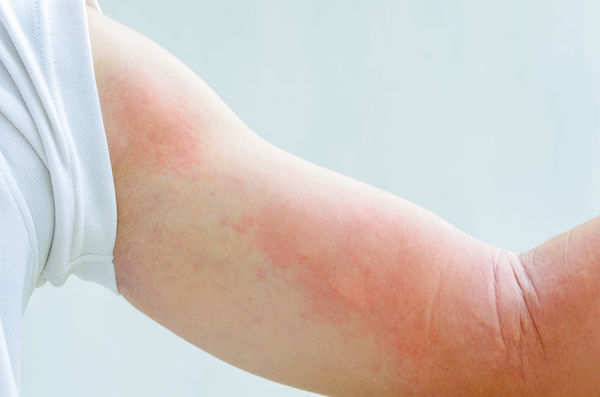Hives are a type of skin rash characterised by itchy, red bumps. Also known as urticaria, this skin reaction results in a raised and itchy rash that fades when the reaction has run its course.

There are numerous possible causes of hives, as they occur when a chemical called histamine is released in the skin. This can happen as a result of allergies, insect bites or stings, infections, exposure to certain chemicals, sunlight, heat or cold, and in response to some medications (often antibiotics or painkillers).
Hives can even develop due to stress or exercise. Medical professionals are not yet sure why the body responds in this way.
What are its symptoms?
The symptoms of hives include:
- Patches of raised bumps (also called wheals) that appear suddenly. Wheals are pale red in colour and can range in size from a millimetre to several centimetres. Individual hives can join together too.
- Itching of the affected area
- Rash may be limited to one part of the body or spread over a greater surface
- Rash lasting several hours after which the skin will return to its normal state
Angio-oedema, a type of rapid swelling usually of the tissues of the mouth, throat, cheeks, feet, hands and genital area, is a related condition that may occur in conjunction with hives.
How is it diagnosed?
Hives can usually be diagnosed based on a physical examination and medical history, which may include questions about possible triggers.
Based on how long the symptoms have persisted, hives can be classified as acute (short-term) or chronic (urticaria that persists for longer than six weeks).
It’s not unusual for doctors to find no identifiable cause of hives, particularly in chronic cases. In some cases allergy testing may be carried out.
What are your treatment options?
Antihistamine medications are a mainstay in the treatment of hives, as they block the action of histamine, the chemical responsible for hives. Non-drowsy antihistamines are available over the counter or your doctor may recommend a daily antihistamine so that the cumulative effects of the drug can manage symptoms of allergies, like hives, before they appear.
Cold compresses and anti-itch lotions can be used as home remedies to relieve the uncomfortable symptoms if a rash has already set in.
In cases where antihistamines don’t offer relief, a short course of corticosteroid medication may be prescribed, although due to numerous side effects this is not a long-term treatment option.
Can it be prevented?
Key to the prevention of hives is avoiding known triggers. Take note of when hives appears – is it after you eat certain foods? In times of stress? After playing with your dog or cat (animal dander is a common allergen)? You may need to keep a food diary to identify possible allergens in your diet.
Once you know what triggers your outbreaks, limiting your exposure to these will reduce your risk of developing hives. Keep in mind though that sometimes hives appears to be spontaneous with no known trigger.
IMAGE CREDIT: 123rf.com
